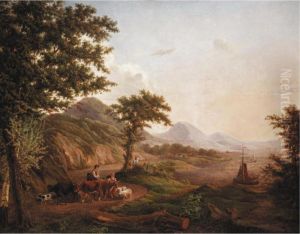Henri Ferdinand Fanton-Lekeu Paintings
Henri Ferdinand Fanton-Lekeu was a Belgian artist, known primarily for his contributions to the art world as a portraitist and landscape painter during the late 19th and early 20th centuries. Born in 1855, Fanton-Lekeu was part of a period that saw a transition from traditional academic art to more modernist movements, though he himself remained largely rooted in the classical tradition with a focus on realism and detail in his works.
Despite the common confusion or association with the better-known Belgian composer Guillaume Lekeu, Henri Fanton-Lekeu carved out his own niche in the visual arts. His career spanned a time of great change in the European art world, including the rise of Impressionism, Post-Impressionism, and the early stages of Expressionism. However, Fanton-Lekeu's works often maintained a fidelity to the realistic portrayal of subjects, whether capturing the nuances of human expression in his portraits or the serene beauty of the Belgian countryside in his landscapes.
Fanton-Lekeu's education and early influences are less documented than those of his contemporaries, but it is evident that he was well-versed in the techniques of his time, perhaps studying at one of the Belgian academies which were central to art education in the period. His style suggests a blend of academic training with an interest in the naturalistic details that would later characterize much of Impressionist work, though he never fully embraced the latter's more radical departures from realism.
Throughout his career, Henri Ferdinand Fanton-Lekeu exhibited his work in various salons and galleries, garnering respect among his peers for his skill, particularly in portraiture. His ability to capture the essence of his subjects made him a sought-after portraitist among the Belgian elite. Despite this, Fanton-Lekeu never achieved the same level of international fame as some of his contemporaries. His landscapes, often depicting rural scenes with a remarkable depth of color and light, show a profound appreciation for the Belgian countryside, suggesting a romantic attachment to the natural world that was common among artists of his time.
Henri Ferdinand Fanton-Lekeu died in 1914, just as the world was on the brink of the First World War, a conflict that would change Europe and its art world forever. Though not as widely remembered as some of his peers, his work remains a testament to the enduring appeal of classical techniques and the portrayal of beauty in an era of rapid change. His paintings can still be found in collections and museums in Belgium and beyond, offering a window into the world of late 19th-century European art.
